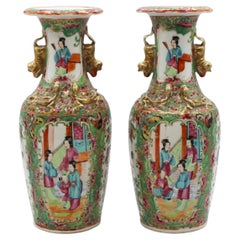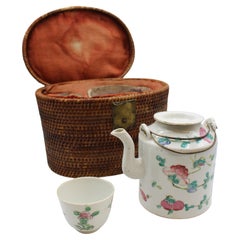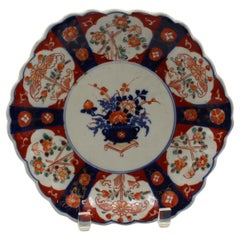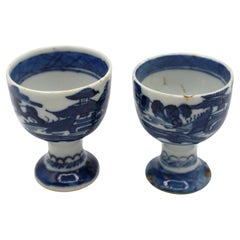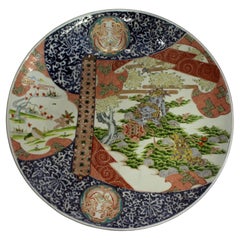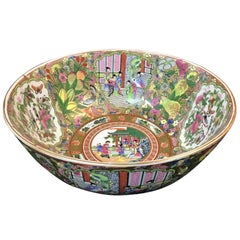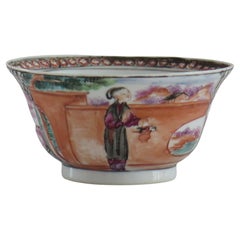Whitehall Antiques Ceramics
to
6
15
15
14
1
1
15
10
1
1
1
14
14
10
4
15
15
15
Pair of Mid-19th Century Chinese Export Porcelain Rose Medallion Vases
By Imari Porcelain
Located in Chapel Hill, NC
Mid-19th century pair of Chinese export porcelain rose medallion vases. Handsome with dragon mounted shoulders & foo lion handles. Fine identical decoration on all sides. Foo lion on...
Category
Antique Mid-19th Century Chinese Chinese Export Ceramics
Materials
Porcelain
Circa 1880s Famille Rose Tea Pot & Tea Bowl in Basket
Located in Chapel Hill, NC
Circa 1880s Famille Rose Tea Pot & Tea Bowl in Basket, Chinese export. Late Qing dynasty. Padded, handwoven wicker basket with brass mounts, interior as is.
Basket: 9.5" x 7.25" x 6...
Category
Antique Late 19th Century Chinese Chinese Export Ceramics
Materials
Porcelain, Wicker
Circa 1890s Japanese Signed Imari Plate
By Imari Porcelain
Located in Chapel Hill, NC
Circa 1890s signed Imari plate, Japanese. With reserves of white pine trees with their colorful Spring cones alternating with burnt orange cartouches with...
Category
Antique 1890s Japanese Meiji Ceramics
Materials
Porcelain
Circa 1880 Scalloped Japanese Imari Plate
By Imari Porcelain
Located in Chapel Hill, NC
Circa 1880 scalloped Imari plate, Japanese. Hexagonal shape. Floral urn on stand central reserve. Well scalloped; cartouches with floral decoration. Underside chip.
9 5/8" x 9 1/4" x...
Category
Antique 1880s Japanese Meiji Ceramics
Materials
Porcelain
Early 19th Century Chinese Export Blue Canton Pair of Egg Cups
Located in Chapel Hill, NC
Early 19th century Chinese Export Blue Canton pair of egg cups. Finely decorated. One with 3/4" hairline. Frits under glaze on both bases; minute frits at rims. 2.25" h., 1.75" dia.
...
Category
Antique Early 19th Century Chinese Chinese Export Ceramics
Materials
Ceramic
Circa 1860-80 Japanese Imari Grand Scale Charger
Located in Chapel Hill, NC
Circa 1860-80 Japanese Imari Grand Scale Charger. Meiji period. Superbly decorated with naturalistic reserves & asymmetric diapered panels; note the foo dog pair. 24.25" dia., 3 3/8"...
Category
Antique Late 19th Century Japanese Meiji Ceramics
Materials
Ceramic
1868-1912 Pair of Japanese Meiji Period Kyoto Satsuma Vases
Located in Chapel Hill, NC
1868-1912 Pair of Meiji Period Kyoto Satsuma Vases, Japan. In the form of tied sash bags/pouches. Four major reserve scenes in gardens. Fine gilding & ov...
Category
Antique Late 19th Century Japanese Meiji Ceramics
Materials
Pottery
Late 19th Century Japanese Massive Scale Arita Blue & White Charger
Located in Chapel Hill, NC
Late 19th century massive scale Arita blue & white charger, Japanese. Pseudo Chinese reign marks. Also called blue & white Imari, as Imari was the export po...
Category
Antique Late 19th Century Japanese Ceramics
Materials
Ceramic, Porcelain
Circa 1860 Chinese Blue & White Porcelain Brush Washer
Located in Chapel Hill, NC
Circa 1860 Chinese blue & white domed form brush washer. Porcelain. From the Qing Dynasty artist or scholar's table. Landscape decoration.
2" dia., 1 5/8" h.
We are a family busines...
Category
Antique 1860s Chinese Qing Ceramics
Materials
Porcelain
Circa 1860 Lozenge Shaped Imari Charger
Located in Chapel Hill, NC
Circa 1860 lozenge shaped Imari Charger, central medallion with birds surrounded by alternating panels with an ancient tortoise & groups of cranes. The reverse well painted. Base rim...
Category
Antique 1860s Japanese Ceramics
Materials
Ceramic, Porcelain
$580 Sale Price
20% Off
Circa 1860 Lozenge Shaped Imari Charger
Located in Chapel Hill, NC
Circa 1860 lozenge shaped Imari Charger. Quadruple quadrants with alternating birds in landscape & naturalistic motifs, surrounding a central medallion of a tea table in garden. Reve...
Category
Antique 1860s Japanese Ceramics
Materials
Ceramic, Porcelain
$620 Sale Price
20% Off
Circa 1870 Imari Chop Plate
Located in Chapel Hill, NC
Circa 1870 Imari chop plate. Well decorated with central floral vase medallion surrounded by alternating small & large cartouche panels with touches of gilt & turquoise in the decora...
Category
Antique 1870s Japanese Ceramics
Materials
Ceramic, Porcelain
$340 Sale Price
20% Off
Circa 1870, Imari Chop Plate
Located in Chapel Hill, NC
Circa 1870 Imari chop plate. Decorated with harmonious alternating garden motif reserves centered by a floral medallion. Japan.
We have been a major sour...
Category
Antique Late 19th Century Japanese Meiji Ceramics
Materials
Ceramic
$220 Sale Price
41% Off
Late 19th Century Aesthetic Movement Imari Charger
Located in Chapel Hill, NC
Late 19th century Aesthetic movement Imari Charger, 15 7/8" dia. Rich, deep colors. Six alternating panels of a bamboo tree in garden with "seaweed" motif & geometric motifs surrounding the central floral medallion. Reverse blue and white decoration.
Whitehall Antiques...
Category
Antique Late 19th Century Japanese Aesthetic Movement Ceramics
Materials
Ceramic, Porcelain
$500 Sale Price
33% Off
1970s, Chinese Mud Figure of Woman
Located in Chapel Hill, NC
Chinese, circa 1970s, mud figure from Wanjiang, Guangong province. A lovely woman in a winter fur trimmed coat holding a rabbit with a goat at her feet. Fin...
Category
Late 20th Century Ceramics
Materials
Ceramic
$75 Sale Price
40% Off
Related Items
Large Porcelain Chinese Export Rose Medallion Bowl
Located in Bradenton, FL
Traditional Chinese Rose Medallion large bowl with social scenes and nature motifs of butterflies, florals, and birds. A very nice larger size bowl! All hand painted with enamel and ...
Category
20th Century Chinese Export Ceramics
Materials
Porcelain
18thC Chinese Porcelain Bowl Hand Painted Famille Rose, Qing Qianlong circa 1760
Located in Lincoln, Lincolnshire
This is a finely hand painted Chinese porcelain bowl from the 18th century, Qing dynasty, Qianlong period, 1736-1795.
The bowl is beautifully decorated with two panels of figure sce...
Category
Antique Mid-18th Century Chinese Chinese Export Ceramics
Materials
Porcelain
$494
H 2.38 in Dm 4.75 in
Antique 19th Century Japanese Imari Scalloped Plate
Located in Pearland, TX
Wonderful 19th century antique Imari plate with scalloped edge. Featuring vibrant oranges, blues, and teal.
Category
Antique 19th Century Japanese Japonisme Ceramics
Materials
Ceramic
Large Antique Qing Dynasty Famille Rose Elaborately Hand-Painted Bowl or Basin
Located in Hamilton, Ontario
This very large and substantial bowl or basin is signed by and unknown artist and originates from China, dating to approximately 1920 and done in the period Chinese Export style. The...
Category
Early 20th Century Chinese Chinese Export Ceramics
Materials
Pottery
$995
H 4.88 in Dm 16 in
Antique Japanese Imari Porcelain Plate #6, Circa 1890's
Located in New Orleans, LA
Antique Japanese Imari Porcelain Plate #6, Circa 1890's. This is the very last plate of a set of 6 that we initially had.
*Ple...
Category
Antique 1890s Japanese Porcelain
Materials
Porcelain
Large Antique Rose Medallion Chinese Export Porcelain Punch Bowl
Located in Philadelphia, PA
A large Chinese Rose Medallion porcelain punch bowl.
In the Rose Medallion (Famille Rose) style.
The central cartouche of the bow...
Category
Early 20th Century Chinese Chinese Export Ceramics
Materials
Porcelain
Large Chinese Export Famille Rose Medallion Porcelain Charger, Mid-19th Century
Located in Atlanta, GA
A richly enameled Chinese Export porcelain charger in the classic Famille Rose Medallion palette, dating to the mid-19th century, Qing Dynasty, circa 1850. This large dish exemplifie...
Category
Antique Mid-19th Century Chinese Chinese Export Ceramics
Materials
Porcelain
$950
H 0.5 in Dm 13 in
Meiji Period Large Japanese Imari Bowl Centerpiece
By Imari Porcelain
Located in Vero Beach, FL
Meiji period large Japanese Imari bowl centerpiece
This large, distinctive, octagonal porcelain Imari bowl is painted in rich, inky blue, co...
Category
Antique 19th Century Japanese Meiji Ceramics
Materials
Porcelain
Pair Antique 19th Century Japanese Imari Porcelain Plates, circa 1890's
Located in New Orleans, LA
Pair antique 19th century Japanese Imari porcelain plates, circa 1890's.
Category
Antique 19th Century Japanese Ceramics
Materials
Porcelain
A Japanese Imari Plate, 19th Century
Located in ARMADALE, VIC
A Japanese Imari Plate, 19th Century
Home decor, Interior design and collectibles.
Provenance: Private Australian Collection.
Dimension: Height: 4.5cm Diameter: 30cm
Category
Antique 19th Century Japanese Ceramics
Materials
Porcelain
Large Chinese Porcelain Famille Rose Medallion Bowl #10
Located in Bradenton, FL
Large colorful vintage Chinese export famille rose medallion porcelain bowl. Features classic oriental scenes with Chinese people throughout. Ov...
Category
Antique 19th Century Chinese Chinese Export Serving Bowls
Materials
Porcelain
Chinese Porcelain Tea Bowl Hand Painted Famille Rose, Qing Qianlong circa 1760
Located in Lincoln, Lincolnshire
This is a finely hand painted Chinese porcelain tea bowl from the 18th century, Qing dynasty, Qianlong period, 1736-1795.
The bowl is well decorated, continuously around the body ...
Category
Antique Mid-18th Century Chinese Qing Ceramics
Materials
Porcelain
